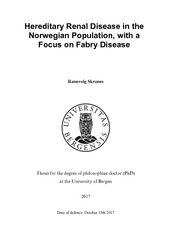| dc.contributor.author | Skrunes, Rannveig | en_US |
| dc.date.accessioned | 2018-01-15T13:57:17Z | |
| dc.date.available | 2018-01-15T13:57:17Z | |
| dc.date.issued | 2017-10-13 | |
| dc.identifier.isbn | 978-82-308-3947-8 | en_US |
| dc.identifier.uri | https://hdl.handle.net/1956/17216 | |
| dc.description.abstract | Background: Clinical experience and studies suggest that end stage renal disease (ESRD) without known Mendelian origins may aggregate in families, and increased risk of death has been reported in relatives of patients with ESRD. In the X-linked Fabry disease, deficient alpha-galactosidase activity causes progressive accumulation of globotriaosylceramide in renal cell types and increased risk of chronic kidney disease. Aims: To investigate the excess risk of ESRD and death associated with having a firstdegree relative with ESRD, and to investigate the effects of enzyme replacement therapy with agalsidase-α or -β in patients with classical Fabry disease. Methods: Papers I and II were retrospective cohort studies. Datasets were obtained through linkage of the Norwegian Population Registry, The Norwegian Nephrology Registry, and The Cause of Death Registry. Relative risk of ESRD and hazard ratios for death were calculated using Cox regression analyses, adjusted for sex, number of first-degree relatives and birth year. Papers III and IV were observational clinical studies, including patients with classical Fabry disease treated with long-term enzyme replacement therapy, who had undergone serial kidney biopsies. The kidney biopsies were evaluated using the scoring system of the International Study Group of Fabry Nephropathy. Results: Paper I included 5 119 134 individuals, 8203 developed ESRD during followup, 27 046 had a first-degree relative with ESRD. Paper II included 5 130 600 individuals. 828 022 individuals died during follow-up, of whom 4105 had a firstdegree relative with ESRD. Having a first-degree relative with ESRD was associated with a relative risk of developing non-hereditary ESRD of 3.7 (95% CI 3.1-4.4). Relative risks of ESRD due to glomerular disease or interstitial diseases were 5.2 (95% CI4.1-6.6) and 4.7 (95% CI 3.1-7.3) respectively. Adjusted hazard ratio (aHR) for allcause death was 1.13 (95% CI 1.09-1.16) in those with a first-degree relative with ESRD. aHR for death due to cardiovascular death was 1.15 (95% CI 1.10-1.21) and aHR for death due to non-hereditary diseases of the kidneys and ureters was 2.29 (95% CI 1.81-2.91). In Paper III reduction and re-accumulation of podocyte Gb3 inclusions was seen in three young Fabry patients after 5 years of agalsidase-β 1.0 mg/kg/every other week and subsequent dose reduction respectively. Dose dependent reduction of podocyte Gb3 inclusions was observed, r=0.693, p=0.001, in the cohort (n=20) included in Paper IV. Podocyte Gb3 reduction was observed in the lower fixed-dose group (p=0.004) as well as the higher dose group (p=0.002), the reduction was significantly greater in those who received agalsidase-β 1.0 mg/kr/every other week leading up to the final biopsy (p=0.01). More patients in the higher dose group cleared the arterial/arteriolar intima of Gb3 inclusions, no statistical change was seen in medial Gb3 burden in either group. Conclusions: Having a first-degree relative with ESRD was associated with a significantly increased relative risk of ESRD, and increased the hazard ratio for death. Taken together this argues for polygenic contributions to risk of ESRD and death in first-degree relatives of patients with ESRD. Agalsidase was found to reduce podocyte Gb3 burden in classical Fabry patients treated for a median of 9.5 years in the lower fixed-dose group and the higher dose group. Dose dependent effects were seen. Limited effects on arteries and arterioles raises concerns regarding the long-term effects on the vasculature. | en_US |
| dc.language.iso | eng | eng |
| dc.publisher | The University of Bergen | eng |
| dc.relation.haspart | Paper I: Familial clustering of ESRD in the Norwegian population. Skrunes, R., Svarstad, E., Reisæter, A. V.,Vikse, B. E. Clin J Am Soc Nephrol. 2014;9(10):1692-700. The article is not available in BORA due to publisher restrictions. The published version is available at: <a href="https://doi.org/10.2215/cjn.01680214" target="blank">https://doi.org/10.2215/cjn.01680214</a> | en_US |
| dc.relation.haspart | Paper II: End Stage Renal Disease Predicts Increased Risk of Death in First Degree Relatives in the Norwegian Population. Skrunes, R., Svarstad, E., Reisæter, A. V., Marti, H. P.,Vikse, B. E. PLoS One. 2016;11(11):e0165026. The article is available at: <a href="http://hdl.handle.net/1956/15233" target="blank"> http://hdl.handle.net/1956/15233</a> | en_US |
| dc.relation.haspart | Paper III: Reaccumulation of globotriaosylceramide in podocytes after agalsidase dose reduction in young Fabry patients. Skrunes, R., Svarstad, E., Kampevold Larsen, K., Leh, S.,Tøndel, C. Nephrol Dial Transplant. 2017 May 1;32(5):807-813. The article is not available in BORA due to publisher restrictions. The published version is available at: <a href=" https://doi.org/10.1093/ndt/gfw094" target="blank"> https://doi.org/10.1093/ndt/gfw094</a> | en_US |
| dc.relation.haspart | Paper IV: Long-term dose dependent agalsidase effects on kidney histology in Fabry Disease. Skrunes, R., Tøndel, C., Leh, S., Kampevold Larsen K., Houge, G., Davidsen, E.S., Hollak, C., Kuilenburg, A.B.P., Vaz, F.M., Svarstad, E. Clin J Am Soc Nephrol. 2017;12(9):1470-1479. The article is not available in BORA due to publisher restrictions. The published version is available at: <a href=" https://doi.org/10.2215/cjn.01820217" target="blank"> https://doi.org/10.2215/cjn.01820217</a> | en_US |
| dc.title | Hereditary renal disease in the Norwegian population, with a focus on Fabry disease | en_US |
| dc.type | Doctoral thesis | |
| dc.rights.holder | Copyright the author. All rights reserved | |
| dc.identifier.cristin | 1501291 | |
